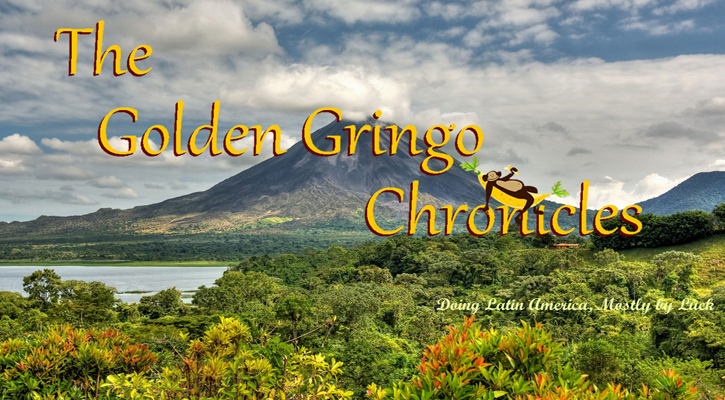

Edition 108 - August 2017
Published at Quepos, Province of Puntarenas, Costa Rica
Publisher: GGC Publications
Editor: Bob Normand, The Golden Gringo, aka "GG"
(©Copyright 2008-2017 All Rights Reserved)
"The mission and goal of the Golden Gringo Chronicles is to provide, in an informative and entertaining way, insight into living the Costa Rican experience as an expat."
1. Broken News (All the News That's Fit to Reprint): In Memoriam; Lights Out in Central America; That's a Lot of Bull; Guanacaste Day; Schmaltzing Matilde the Computer; Quepos Quickies: (Going Fiber Optic, New Welcome Sign; Monkey Business, More Monkey Business)
2. Rumble Talk (Shaky Happenings Around the Pacific Rim and Maybe a Little Weather Talk Also): Little Rumbling but Rains and Rain Damage Continue.
3. ¿Que Es Eso? Department (¿A Tico Mystery?): Look Who's Smiling But What Does It Have To Do With Insect Control?
4. Feature Article: Piña Power and Its Problems (Costa Rica's Pineapple Industry)
5. Feature Article: Living On and With the Cordillera (Costa Rica's Central Mountain Range)
6. Health Stuff (Especially as it Relates to Costa Rica): St. Jude's Researching Aging; UCR/Kansas U. Joint Study Tries to Answer: Who Ages Better, Gringos or Ticos?; Nicoya Designated One of Four U.N. "Blue Zones" in the world.
7. What's-in-a-Word (Adventures in Etymology): (Answer to Que Es Eso, Etymology of Pineapple, Cordillera)
8. ROMEO Corner (Retired Old Men Eating Out - Aging Gourmands On The Prowl): El Wagon, Manuel Antonio
Wisdom of the Ages
“The error of youth is to believe that intelligence is a substitute for experience, while the error of age is to believe experience is a substitute for intelligence.” |
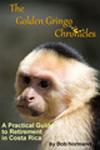 |
RECENTLY RELEASED! Mariposa, A Love Story of Costa Rica RECENTLY RELEASED!
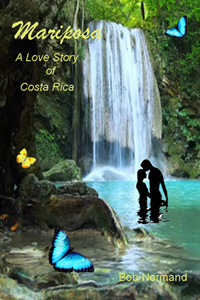 Five hundred years before the Spanish found the American
continent, around the end of the first millennium, Native Americans lived and prospered in Central America, including the land now known as Costa Rica. Truly a natural wonderland then and now, the natives were able to employ their farming skills and prosper from the rich soils, the forests filled with game, herbs, and spices, and the lakes and two oceans rich with fish and crustaceans.
Five hundred years before the Spanish found the American
continent, around the end of the first millennium, Native Americans lived and prospered in Central America, including the land now known as Costa Rica. Truly a natural wonderland then and now, the natives were able to employ their farming skills and prosper from the rich soils, the forests filled with game, herbs, and spices, and the lakes and two oceans rich with fish and crustaceans.
Mariposa, or butterfly, is a story about two young Native Americans, each a favored child of a chief, but of different tribes. These two tribes, historically hostile to each other, lived a few days march apart in the mountains north and east of Costa Rica’s central valley.
The two natives meet by accident, fall in love and begin to plan a life together only to be frustrated by events beyond their control. The lovers are eventually drawn to a mountain volcano which is thought by many to be the home of the gods, particularly Sib'ö, the Great Spirit, who they believe had created the world.
 The story as written incorporates the classic ending of Costa Rica's Legend of Zurqui, one that reflects the beauty, mystery and spirituality that is Costa Rica. Mariposa is available in both English and Spanish versions.
The story as written incorporates the classic ending of Costa Rica's Legend of Zurqui, one that reflects the beauty, mystery and spirituality that is Costa Rica. Mariposa is available in both English and Spanish versions.
Preview the Book (English) on Amazon.com at: Mariposa Preview (This is Chapter 1 in its entirety):
Broken News
(All the News That's Fit to Reprint)
In Memoriam
 |
| Stanley Jay Astrachan |
On Wednesday, July 12 at 2:15 PM, a tragic accident occurred not far from my apartment that took the life of a gentleman I knew mostly as Stan or "Stan the Man", a gringo who had been living here for many years. Stan was crossing the street in front of Super Jordix, a market GG shops in almost daily and is only two blocks from my home, when a motorcyclist traveling at high speed ran him over. Stan suffered major traumatic injuries and blood loss and later died at Quepos Hospital.
The motorcyclist, reported later as underage and without a license, fled the scene despite efforts by local residents to hold him. He later turned himself in to the police.
Stan always had a smile for people and had been very helpful to many on "border runs", i.e., making trips to the border to renew a visa every 90 days until a cédula (residency document) is obtained. That's where I first met him, taking a few of those trips with Stan and others to Panama and the border to get an updated visa. These trips often became adventures, bringing new and better friendships and camaraderie among we expats and I will remember the good times we had for a long time. Stan also was a good bread maker and sold several types of homemade goodies to hungry expats and Ticos here.
GG's condolences go out to Stan's family and friends for their loss and ours.
The supermarket security cam caught the incident on video. It has already been published on Facebook, and it can be seen HERE, but beware, it's graphic and startling.
Rest in peace amigo, you don't have to worry about any more border runs to update your visa.
Lights Out in Central America
All of a sudden on Saturday, July 1 around 1:15 PM the power in my apartment went out and my computer screen dropped in brightness, as the system automatically shifted to the battery.
Now this is not an unusual event; we get power outages fairly frequently here which last from a few seconds to an hour or two. Some years ago, after living here a year or so, I made a bet with another expat who had moved here, to wit: "If in any week we experience that all utilities have worked without interruption; i.e., power, telephone, cable and internet, I will buy you lunch at any restaurant in the area you want!". In the seven years he lived here, I never had to pay up.
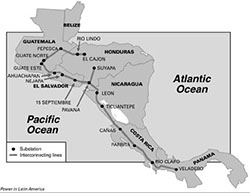 |
| Central American Power Grid |
 |
| Traffic Lights Out in San José Caused Traffic Jams in Many Places |
But this latest power outage was different. It would last for almost five hours, which is enough time for my puter to run out of battery and the refrigerator to warm up.
We learned later that there had been a power surge in Panama that had created a domino effect and brought down the entire Central American power grid all the way up to Guatemala. No bueno amigo. General public confusion ensued, particularly in populous San José with traffic lights out. Stores and restaurants were forced to close and even the main airport, Juan Santamaria, had to delay operations. Slowly, one power station at a time resumed operation and by late afternoon the grid was back.
We often take electricity for granted, don't ya think?
That's a Lot of Bull
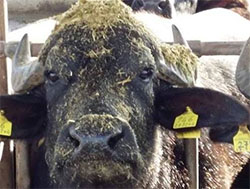
Costa Rican scientists at the University of Costa Rica have been studying the relative nutritional value of meat from beef cattle versus that from buffalo. Conclusion about buffalo meat: "It is more nutritious and iron enriched than that of cows, it has a lower percentage of fats and calories and it is as soft as beef. The panel found no significant
flavor differences, however, they did confirm greater softness and juiciness in the buffalo meat." (do they really mean "tender" rather than "soft"? - just asking; more tender meat would definitely be an improvement here) The researchers also concluded other advantages for buffalo; they mature to sales value faster, are able to handle hot weather and parasites better, have a longer female fertility period (25 years) and a higher fertility efficiency (92%).
The one press report that GG read said there are now about 50 buffalo producers in Costa Rica organized into a professional association called Asobúfalo (come on amigos, where's the long acronym?). Fifty plus producers, really? I've never seen buffalo identified on the menu - do you think they might not be telling us when it's not beef?
GG had buffalo once at a steak house in Castle Roca, Colorado on a business trip. It was delicious. I also saw "Rocky Mountain Oysters" (bull testicles) on the appetizer list and the dumb Yankee in me asked "Do you get two?" The waitress smiled and said "I'm sure you'll find one is enough sir." Just asking dear, but I finally settled on the shrimp cocktail anyway.
Guanacaste Day
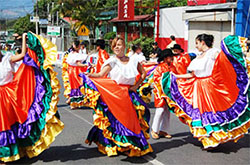 |
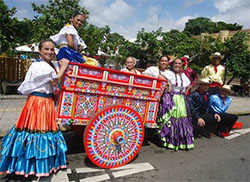 |
| Guanacaste Day Dancers and Parade |
Tuesday, July 25, was a national holiday in Costa Rica, officially Anexión del Partido de Nicoya a Costa Rica (the Annexation of Guanacaste). It is one of the 11 national holidays in Costa Rica and one of the 9 mandatory paid holidays. Banks, Government Offices and many businesses and other services take the day off (maybe two this year because Monday preceded the holiday).
Up until 1821 when most of Latin American countries including Costa Rica declared their independence from Spain the area now called Guanacaste was designated by the Spanish as the Partido de Nicoya and was considered neither Nicaraguan nor Costa Rican.
A referendum held by the people in the area shortly after independence resulted in an overwhelming positive vote for conjoining the province to Costa Rica (I don't think the Nicas ever forgave us). The annexation was complete in 1824 and has been celebrated on July 25 ever since. In a separate press report, geologists were quoted as pointing out that the Nicoya Peninsula, because of the tectonic plate activity close to it and under it, is causing the province to move north a few inches every year. As one Tico wag put it: "Just wait Nicas, you'll get the Nicoya back in about nine million years, when it becomes a suburb of Managua."
But for today, out come the dancers in their colorful dresses (photo), the "tipico" Costa Rican wagons on parade and the Marimba players and all is well with the world, at least for today and locally.
Scmaltzing Matilde the Computer
 |
| Matilde Being Used (1960's Photo) |
So GG was reading a local electronic newspaper when he came across an article that claimed the first scientific computer (read electronic computational device) in Costa Rica, and Central America for that matter, was an IBM Model 1620 used at the University of Costa Rica in the 1960's. That machine (see photo left), originally named Matilde, has been relegated today to a museum display in the University's library (see photo below).
Woe, wait a minute; did I just read IBM 1620?
My oh my, history does repeat itself, or at least nostalgia does. GG used an IBM 1620 as part of his grad school thesis (1965-66) to do a mathematical simulation of a chemical process; lots of incremental iterations of differential equations to mimic and predict organic separation of organic liquids by a plastic membrane (don't ask, it doesn't matter any more). Many an hour passed feeding the 1620 a pile of punch cards (OK, the millennials can start laughing now) and converting the output, another pile of punch cards, to wide, 1/2 inch green bar paper reports. The console I sat in front of to make the runs looked exactly like the one in the photo above (except that one seems to have advanced to include teletype output).
 |
| Matilde Today - On Display |
Matilde today would be highly embarrassed by the capacity and speed of my little Dell Laptop. The 1620 was so slow (at the time it seemed super fast, especially when we compared it to an electric calculator) that you could see where it was in the string of equations it was trying to solve by watching the bank of lights on the console. Matilde and her brothers and sisters only were able to read and speak the FORTRAN programming language, my first language after English; sigh.
Just a bit of computer nostalgia amigos; life was slower but simpler then.
Quepos Quickies
Going Fiber Optic. ICE (our national power and telecom company) recently announced a project to replace much of their copper wire telecom network in the Canton of Quepos with fiber optic cable, making the Quepos area only the second region in the country to be so served (I presume San Jose was the first). This will be done in two phases, the first of which is supposed to be completed by March of 2018. Says an ICE rep: “With the implementation of this fiber optic network, we will be able to offer our customers greater bandwidth with speeds of up to 100 MBps, high definition television and other services that previously could not be provided.” Yes, bring it on amigos! At the moment I'd just settle for the internet not slowing down and sometimes stopping most afternoons.
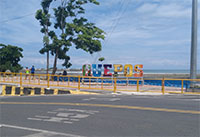
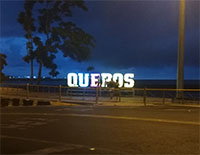 New Welcome Sign for Quepos. Seems the Municipalidad of Quepos has tried once again to enhance the north entrance into Quepos. The new modern, two-lane bridge helped relieve a bottleneck there and now the city has added the sign shown to the left (daytime) and right (it lights up in the nighttime). I guess adding "Beinvenidos a" would have put them over budget, but the sign is a bright improvement nevertheless. The older wags downtown told me, however, that they don't expect it to be there too long as it's already been subject to one case of vandalism, after all it is on the north entrance to the Malecón, not the nicest area of town at night.
New Welcome Sign for Quepos. Seems the Municipalidad of Quepos has tried once again to enhance the north entrance into Quepos. The new modern, two-lane bridge helped relieve a bottleneck there and now the city has added the sign shown to the left (daytime) and right (it lights up in the nighttime). I guess adding "Beinvenidos a" would have put them over budget, but the sign is a bright improvement nevertheless. The older wags downtown told me, however, that they don't expect it to be there too long as it's already been subject to one case of vandalism, after all it is on the north entrance to the Malecón, not the nicest area of town at night.
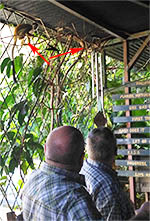 Monkey Business. Recently, several of us were enjoying breakfast at a restaurant in Manuel Antonio that is open to the jungle when we got some curious visitors, a pair of Titi monkeys. They're not curious to us, we see them frequently, but we were apparently curious to them. More likely they were just hungry.
Monkey Business. Recently, several of us were enjoying breakfast at a restaurant in Manuel Antonio that is open to the jungle when we got some curious visitors, a pair of Titi monkeys. They're not curious to us, we see them frequently, but we were apparently curious to them. More likely they were just hungry.
 They squeaked and chattered away for several minutes watching us devour our gallo pinto and eggs. They came closer and closer but didn't quite get up the courage to jump on the table. That was good because feeding wild monkeys is a no-no, and we say that for their own benefit. If you want to know why, there are eleven reasons why humans should not feed the monkeys to see them go here:
They squeaked and chattered away for several minutes watching us devour our gallo pinto and eggs. They came closer and closer but didn't quite get up the courage to jump on the table. That was good because feeding wild monkeys is a no-no, and we say that for their own benefit. If you want to know why, there are eleven reasons why humans should not feed the monkeys to see them go here:
http://www.kidssavingtherainforest.org/dont-feed-monkeys.html
 |
| Burned Out Drug Runner? |
More Monkey Business. In this case, the human kind. Costa Rica and Quepos, as has been mentioned frequently, are hotbeds of "natureleza" or nature, making it an attractive place to live. That, and the fact that the country is strategically located in the middle of the major transit route from the drug-growing regions of South America such as Colombia also make it a perfect place for a refueling stop for small aircraft, the kind used in moving drugs around.
The government has recently undertaken a search program for clandestine air strips around the country and they have turned up some 80+ runways in the last year. They recently found one near Quepos which was nothing more than an unpaved road in the jungle. They also found a burned out airplane. It was Cessna size, with a false registration belonging to another Colombian aircraft. Perhaps it crashed there or failed mechanically and was purposefully destroyed, who knows?
¡Pura Vida!
Not much in the rumble department to report this month except the usual several hundred minor shakings that the University of Costa Rica seismograph registered, most of which were below human sensing level.
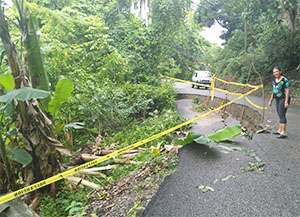 But the rains continue. I can't seem to find anybody who has a verified measurement of how many centimeters or inches we've received so far this year but I wouldn't be surprised if it registered in the top 10% of recorded history, at least on a year-to-date basis. One of the things that seems different to GG is the fact we've had many mornings of rain. Heretofore, in my experience, almost all days, including the rainy season started with the sun prevailing until at least noon or early afternoon. I used to brag about that to visitors but this year I've had to hold my tongue.
But the rains continue. I can't seem to find anybody who has a verified measurement of how many centimeters or inches we've received so far this year but I wouldn't be surprised if it registered in the top 10% of recorded history, at least on a year-to-date basis. One of the things that seems different to GG is the fact we've had many mornings of rain. Heretofore, in my experience, almost all days, including the rainy season started with the sun prevailing until at least noon or early afternoon. I used to brag about that to visitors but this year I've had to hold my tongue.
One of the more interesting aspects of the current weather pattern is that some of the heaviest rains were not down in the rainforest where GG is but in the central part of the country. In particular the Canton of San Carlos which is north, north-west of San José towards the Nicaraguan border has had significant damage to water and sewer pipes and several houses severely damaged due to swollen rivers.
But we've had problems in our area also. Continuing rains are bound to have damaging consequences in a country that has many hills and mountains, particularly in the form of landslides. Such was the case recently on the "Old Road to Quepos", a road that was only paved a couple of years ago. An unexpected slide occurred (photo above left) in an area near the restaurant where we recently saw the Titi monkeys (reported in the Quepos Quickies section/Broken News above). This slide ruptured the main water pipe to Manuel Antonio and it took almost 24 hours to repair the pipe. The road, or the remaining half of it, is still unrepaired as of this writing but is still being used, even by heavy trucks (don't ask).
Check Out Recent Earthquakes Around the World Posted by the U.S. Geodetic Survey: Today's Quakes |
Search the Golden Gringo Chronicles Archives for Topics That Interest You
You can use our Archives to search for anything that has been written in more than 200 feature articles of the Golden Gringo Chronicles plus find Broken News items and ROMEO restaurant reviews. Enter your topic or item to search in the Google Search Routine below and follow the links offered from the search results. Suggestion: Enter only a simple, precise and unique as possible keyword or two in order to narrow the number of references retrieved:
Readers: Our publication is open to suggestions regarding future articles and will accept pieces written by others but we reserve the right to decline anything that the editorial staff (that's GG) thinks is inappropriate for this format. Send proposals, comments, suggestions, ideas, meaningless statements and jocular observations concerning the Chronicles to GG here: gg@goldengringo.com.
The Power of Pineapple
One of the things that can be enjoyed daily in Costa Rica is the seemingly endless supplies of fresh fruits and vegetables. The fruits in particular are awesome and pineapple is right at the top of that list.
 Since living here I've come to buy fresh pineapple, papaya and mangoes weekly and process them into Tupperware containers in order to make the composition shown at right which I eat for breakfast three to four times per week. It's a big bowl of papaya, pineapple and mango chunks. Sometimes I add a banana, some dried cranberries or dried, chopped prunes, then cover it with liquid yogurt like the blackberry flavor shown. Yummers.
Since living here I've come to buy fresh pineapple, papaya and mangoes weekly and process them into Tupperware containers in order to make the composition shown at right which I eat for breakfast three to four times per week. It's a big bowl of papaya, pineapple and mango chunks. Sometimes I add a banana, some dried cranberries or dried, chopped prunes, then cover it with liquid yogurt like the blackberry flavor shown. Yummers.
Of course, since going on my low carb diet, I've seriously cut back or eliminated the dried fruit (very high sugar/carbohydrates) and replaced the yogurt (milk products are high on carbs) with heavy cream (zero carbs). But without those, it's not quite as interesting eating as my original recipe.
The pineapple is believed to have first been discovered in the jungle area between Brazil and Paraguay, particularly along the Paraguay River which joins other major rivers and empties into the Rio de la Plata near 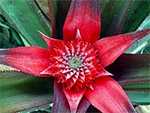 Buenos Aries. The pineapple plant eventually wandered north by indigenous migration but no hard record seems to exist as to when it arrived in Central America. (see What's-in-a-Word section below for etymology of Pineapple)
Buenos Aries. The pineapple plant eventually wandered north by indigenous migration but no hard record seems to exist as to when it arrived in Central America. (see What's-in-a-Word section below for etymology of Pineapple)
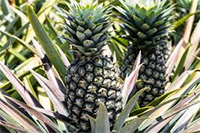 |
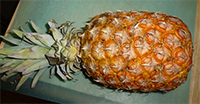 |
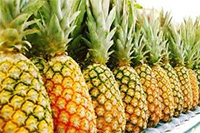 |
| Pineapple - Unripe (top), Overly Ripe (center) and Just Right (bottom) |
Señor Cristóbal Colón (aka, Columbus) first came upon a pineapple in 1493 on the Caribbean Island of Guadeloupe (been there, beautiful place) and he brought back a plant to Spain, becoming the first to export it outside the new world. The plant is of the bromeliad family, which is easy to believe when you look at the flower to the left, which is a pineapple in the budding. Those little buds at the center, which can number as many as a hundred, eventually coalesce into forming the fruit, leaving behind the rough, bumpy surface we're used to.
Old GG has gotten good at choosing a pineapple that is not too green and not too yellow. I was not a fan of fresh pineapple in the states; all I can remember is fruit that was bright forest green on the outside and that was not very sweet; and that was because it was not ripe. There's no excuse for shipping fruit that green (except to sell it faster) because pineapple does not appreciably ripen off the vine. It may take weeks, even months but will end up rotting before it ripens more.
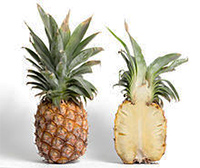 A perfectly ripe pineapple still has a touch of green on the body of the fruit, particularly near the top, but it shows a yellow to golden-yellow color over the rest of the fruit (see comparison right) and the sweetness and juiciness of the fruit varies slightly from the top (good) to the bottom (best) of the fruit.
A perfectly ripe pineapple still has a touch of green on the body of the fruit, particularly near the top, but it shows a yellow to golden-yellow color over the rest of the fruit (see comparison right) and the sweetness and juiciness of the fruit varies slightly from the top (good) to the bottom (best) of the fruit.
To process the fruit, simply twist off the leaves, slice off the top below the stem root (if you have space in your garden you might want to replant the top as it will grow into a new plant), then slice about a half inch off the bottom, then turn the fruit up vertically and slice the rough sides off downward in about 4-6 strokes . The fruit can then be chopped into pieces or sliced. I personally like to remove the center core (see photo left) which runs a half to three-quarters of an inch in diameter and which I find tougher that the rest of the fruit but many people leave it as is in the chunks or slices.
Is there anything better than just a bunch of fresh pineapple over some really good vanilla ice cream, perhaps with a little chocolate syrup? And we don't need to suggest the obvious, that pineapple makes a great base for smoothies and many other drinks. But, in addition to a myriad of food uses, the unusual physical shape of a pineapple has been emulated in other ways and its shape found its way into art, decor and even architecture; just look at these examples:
 |
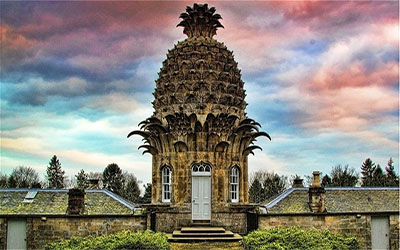 |
 |
Cubic Painting Left Does Justice to the Unusual Surface of a Pineapple While the Lamp Shade and Base (Right) Matches the Wallpaper. The Building in the Center is Called the Dunmore Pineapple and is in Scotland |
||
The "Dunmore Pineapple" shown above was built as a hothouse in the 1760's by the Earl of Dunmore who evidently liked pineapples a lot. The hothouse was actually used to grow pineapples and provided an environment that sheltered them from the harsh Scottish winter. The Earl's castle and estate was in Airth, Sterlingshire, Scotland and the hothouse has since been ranked as "the most bizarre building in Scotland" by the locals. When GG read that it was in Airth, I had another one of those nostalgic stirrings, because I stayed at the Castle Airth a few times in the '70's (1970's not 1770's) traveling to our office in Grangemouth on business; yet I don't remember the pineapple house (might be because the Malt Scotches were really good back then). But let's get back to Costa Rica.
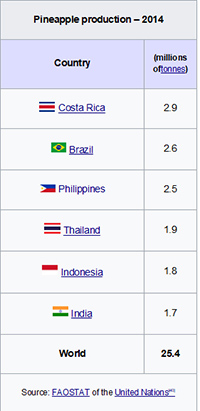 GG knew that pineapples were an important agricultural export product in Costa Rica but until researching this article I didn't realize just how important the industry here is to the economy, and for that matter, to the world. The chart at left shows worldwide production of pineapples in 2014; note that Costa Rica leads the list with 11% of total global production or 2.9 million tonnes (that's 6.4 billion lbs and that's a lot of Piña Colada baby).
GG knew that pineapples were an important agricultural export product in Costa Rica but until researching this article I didn't realize just how important the industry here is to the economy, and for that matter, to the world. The chart at left shows worldwide production of pineapples in 2014; note that Costa Rica leads the list with 11% of total global production or 2.9 million tonnes (that's 6.4 billion lbs and that's a lot of Piña Colada baby).
So, when you think pineapple, think Costa Rica.
While there are a number of species of pineapple available, the golden variety produced in Costa Rica is the favorite around the world. Europe is one of the major markets for CR exports and imports to that continent account for over 40% of total worldwide exports of pineapples. Of that, 92% of Central American exports to Europe come from Costa Rica.
CANAPEP (the Spanish acronym for the Costa Rican Camera [Chamber] of Pineapple Producers and Exporters - Ticos sure love their acronyms, don't they?) offers stats that say the Costa Rican pineapple industry directly employs over 23,000 workers and indirectly another 92,000. Somewhere over 40,000 hectares (100,000 acres) of Costa Rican farmland are currently producing pineapples and while there are a few major producers, like Dole, Del Monte and Tesco PLC (the U. K.-based grocery and general merchandise retail giant), there are also at least 1,200 small and medium sized pineapple producers who are native to Costa Rica.
So pineapples are important to the livelihood of many farmers as well as to the country's economy.
And the Problems...
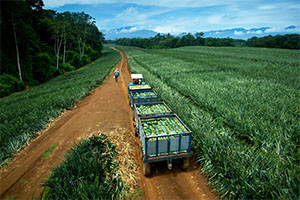 |
| A Large Costa Rican Pineapple Farm |
While the importance of the pineapple industry is indisputable, further expansion of such farming is also becoming controversial.
It's worth remembering that there was virtually no commercial pineapple production in Costa Rica until the 1970's. Since then, the growth in pineapple farming has exploded such that the country, as mentioned above, is now the greatest producer of the fruit in the world. During the period 2001 to 2014 alone Costa Rican output grew from about 300,000 tonnes to 2,900,000 tonnes, a compounded annual growth rate of nearly 20% (that's in the Amazon and Uber league).
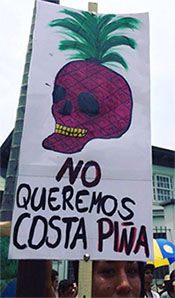 |
| The Protester's Sign Says: "We Don't Want (to be) Costa Pineapple" |
Insects like the sweetness of pineapple too. Unfortunately, in an effort to protect the fruit and deliver it disease free to the consumer, various insecticides came into use, and perhaps overuse, and these can present health risks if not controlled well. This can occur both from direct contact by workers or through contamination of water supplies. One of these insecticides, Bromacil, has been claimed to cause health problems with workers, most of which are immigrants from Nicaragua who found work here, and the chemical is expected to be banned soon.
Lately there have been demonstrations by various environmental groups objecting to further expansion of pineapple farms. A recent 602 hectare (1,500 acre) site in the South Pacific region proposed by the Del Monte subsidiary here, and approved by the government's environmental ministry (MINAE), is under attack by these groups. They believe the project will encroach on certain wetlands and U.N. Worldwide Heritage Sites (indigenous lands) and further study is being conducted even though the companies claim they satisfied all the requirements in receiving their permit.
So, while the pineapple industry continues to be important to the Costa Rican economy, we may be seeing a peaking of the industry in Costa Rica. Stay tuned for more developments. And don't forget to enjoy our great pineapple.
¡Pura Vida!

Who is this guy and why is he smiling?
Maybe he just won the lottery?
Maybe he's celebrating his birthday (25 April, 1958), a little longer than usual this year?
Maybe he ate the whole pineapple himself?
Answer in What's-in-a-Word section below.
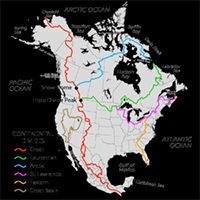 |
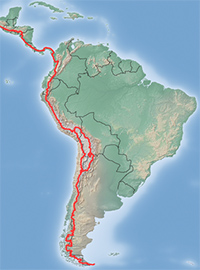 |
| The American Continental Divide & Cordillera |
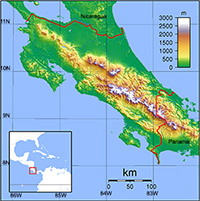 On the American Continent we have the Continental Divide which runs from the north of Alaska all the way down the state, then down through the Canadian Rockies, the U. S. Rockies, down through Mexico, Central America including Costa Rica, then through South America and finally emerging in Tierra del Fuego, Chile at the southern tip of the continent.
On the American Continent we have the Continental Divide which runs from the north of Alaska all the way down the state, then down through the Canadian Rockies, the U. S. Rockies, down through Mexico, Central America including Costa Rica, then through South America and finally emerging in Tierra del Fuego, Chile at the southern tip of the continent. 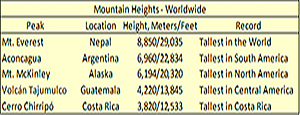 While 3,000 meters is a sizable peak, that height carries no records, that's for sure; just look at the table to the right that summarizes a selected group of record holding mountain heights around the world. Costa Rica's tallest mountain, Cerro Chiripó comes in at a modest 3,820 meters or 13,533 feet and is less than half the height of the world's tallest mountain, Mt. Everest in Nepal-China. It's also shorter than the tallest mountains in Central America, South America and and North America.
While 3,000 meters is a sizable peak, that height carries no records, that's for sure; just look at the table to the right that summarizes a selected group of record holding mountain heights around the world. Costa Rica's tallest mountain, Cerro Chiripó comes in at a modest 3,820 meters or 13,533 feet and is less than half the height of the world's tallest mountain, Mt. Everest in Nepal-China. It's also shorter than the tallest mountains in Central America, South America and and North America. 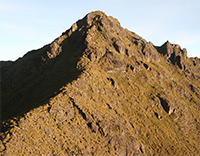 |
| Cerro Chiripó |
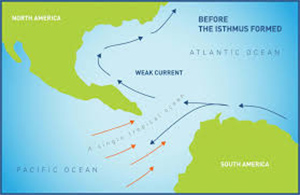 |
| Costa Rica/Panama 100 Million Years Ago (They Didn't Exist) |
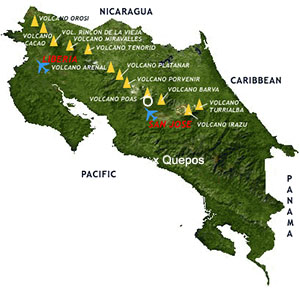 So the Cocos and Caribbean plates rubbed together and created the land bridge now called Costa Rica and Panama and came to connect North and South America. The continued action of these two plates, while unlikely to repeat the violence of twenty million years ago when the isthmus was formed, can stilloffer up volcanic activity and major earthquakes (like the 7.6 doozie GG experienced in 2012).
So the Cocos and Caribbean plates rubbed together and created the land bridge now called Costa Rica and Panama and came to connect North and South America. The continued action of these two plates, while unlikely to repeat the violence of twenty million years ago when the isthmus was formed, can stilloffer up volcanic activity and major earthquakes (like the 7.6 doozie GG experienced in 2012).
The Cordillera Central of Costa Rica now is home to a string of volcanoes that run almost the entire length of the Cordillera and the country (see map left). In recent months, three of these funnels have been active (as you go up the spine on the map they are Turrialba, Poas and Rincon de la Vieja. Others that have had their say in recent years include Arenal, a popular tourist destination.
The physical creation of the isthmus land bridge slowly developed into wide, lower plains on both sides of the cordillera, including what we now call the Central Valley where San José is located. As the literature puts it: "...wind erosion, intense ultra violet bombardment, torrential rains, water erosion, abundant landslides, and sedimentation filled in the gaps creating a fertile and porous volcanic soil". Fertile, you bet. I've often said that some of the soil here is so rich that I think you could grow rocks in it.
The land bridge provided another very important evolution, the ability for people, plants and fauna to migrate more easily north and south. The article above mentions that the pineapple plant is originally thought to have come up from the amazon region. It's highly likely indigenous people brought the first plant with them as they migrated north. The current indigenous people remaining in the Caribbean and southern provinces of Costa Rica have been tied genetically to South American tribes, particularly from Colombia.
The land bridge, being in the center of the continent not too far from either North America or South America also provided for a gathering place for indigenous migrants from those regions; from Mexico came a split off of the Mayas who came to be known as the Chorotegas and who settled in Guanacaste. So the countries that rose from the deep played an important role in developing the entire American continent.
For more on how history developed here before Europeans reached the continent go HERE.
¡Pura Vida!
| Note: The information given in this section is offered as news information only and does not indicate GGC confirmation or denial of the accuracy of the treatment or a recommendation to pursue it, nor can we or do we guarantee the efficacy of the results nor validity of the conclusions proffered.
(How's that for a disclaimer?) |
The press this month was replete with stories about aging and studies about aging; or am I just naturally drawn to these stories, these days? Any way, here are some of them:
St. Jude Children’s Research Hospital
It is well known that as people age they lose a significant ability to learn new languages and to hear and play music as successfully as they do when younger (just ask the old fossil writing this). St. Jude's is trying to find out why this happens. Of all people to be working in this field, I wouldn't have expected St. Jude's Children's Hospital to be involved, but researchers there have been working to identify the function of a "neuromodulator" called adenosine.
“By disrupting adenosine signaling in the auditory thalamus, we have extended the window for auditory learning for the longest period yet reported, well into adulthood and far beyond the usual critical period in mice.” English translation: The research suggests the possibility that the time for learning a language and music might be significantly extended in adult humans. The researchers will next try to develop a pill that acts like adenosine.
OK, but hold the pill guys, I have enough of those already. I'll bet you can find the stuff (i.e., "adenosine interrupters") in something that grows in Costa Rica and that's edible. Let GG know if you need a volunteer.
UCR/Kansas U. Study
 |
| Gringo Volunteer (Not GG - He's Too Thin) |
Life expectancies at birth for Costa Ricans and Americans (that is, the U.S. type) have been running neck and neck with each other for some years now. In 2015, the World Health Organization listed life expectancy in Costa Rica at 79.6 years and for the U.S., 79.3 years. On the surface, very little difference. Yet researchers at the University of Costa Rica have recently joined researchers from Kansas University to study and answer some basic related questions: Do Gringos or Ticos age better, what advantages or factors does each group have and can they be exploited to help each other?
A group of 100 Gringo volunteers who live in Kansas and 78 Tico volunteers who live in the Central Valley of Costa Rica have been solicited and scheduled to take part in the study. They report to their respective medical centers regularly for standardized testing of their physical (e.g., respiration and oxygenation capacity) and cognitive abilities (e.g., reaction times to stimuli change, focus ability).
Hold on to what you've got folks because the initial phase of the study won't be reported on until 2020. In the meantime friends and amigos running the study you might want to expand your reach to include people in Japan, Switzerland and Singapore, the top three countries in life expectancy at 83.7, 83.4 and 83.1 respectively. I can understand perhaps, that sushi and rice might have something to do with the Japan and Singapore ratings, but Switzerland? Might it be the clean mountain air or could it be the chocolate fondue?
While St. Jude's and the universities' studies were going on, another one was set to begin on the Nicoya Peninsula in Costa Rica.
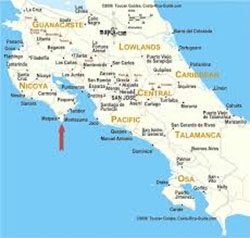 The United Nations recently declared, decreed or just announced that Costa Rica 's Nicoya Peninsula (red arrow on map left) is now a "Blue Zone", one of only four in the world to be so designated, after the island of Sardinia in Italy, the Greek island of Icaria in the Aegean Sea and (of all places), Loma Linda, California in the Los Angeles basin. Quepos is only about a 100 kilometers or 60 miles from the southern tip of the Nicoya as the seagull flies.
The United Nations recently declared, decreed or just announced that Costa Rica 's Nicoya Peninsula (red arrow on map left) is now a "Blue Zone", one of only four in the world to be so designated, after the island of Sardinia in Italy, the Greek island of Icaria in the Aegean Sea and (of all places), Loma Linda, California in the Los Angeles basin. Quepos is only about a 100 kilometers or 60 miles from the southern tip of the Nicoya as the seagull flies.
What is a "Blue Zone", inquiring minds want to ask? It's an area where there is an unusually high percentage of centenarians, yup, that's right, people over 100 years old. Exactly what percentage or number of the population being 100+ qualifies an area to be a blue zone wasn't disclosed in the press article.
A group of geriatricians and gerontologists from the Hospital Nacional de Geriatría y Gerontología (GG didn't even know we had one of those) in San José. They began their research studies in the Nicoya recently, identifying some 42 centenarians on their first sweep. The biggest town in the whole region, also called Nicoya, is only 13,342 in population.
The ministry of health in reports that there are 626 centenarians in Costa Rica. The U.S. actually has more centenarians as a per cent of population than Costa Rica, to wit, 53,364 or 16.6 per 100,000 versus Costa Rica at 626 or 13.0 per 100,000. Most of those dudes must all be living in Loma Linda, since it's still the only Blue Zone recognized in the U.S.
So what are those amigos in the Nicoya eating besides gallo pinto? GGC will stay on the story - results from this study are expected in 2018.
¡Solo Bueno!

Answer to Que Es Eso?
If I'm not mistaken (and I'm not) the fellow smiling and laughing in the Que Es Eso photo above is none other than Luis Guillermo Solís Rivera, the 47th and current president of Costa Rica.
Señor Solís was out in the street with the people and was being interviewed by PZactual.com, a San Isidro based on-line paper when a wasp flew up in front of his face. As any good politician would, Solís didn't miss a beat in talking. Instead he swallowed the wasp when it entered his month. "¡Yo comi la avispa!" ("I ate the wasp!"). Watch the video above closely to see the wasp fly into his mouth, and see how cool he was about the unexpected meal. Note: this video comes with the audio muted, so click on the lower menu bar on the video and turn on the audio.
 Fifty-nine year old Solís became president of Costa Rica in May of 2014, succeeding Laura Chinchilla, the country's first woman president. He was born in San José, the son of a teacher and a shoemaker, and his family lived in Turrialba for many years. He was president of the student body in high school, received a degree with honors from the University of Costa Rica and got a Master's Degree in Latin American Studies at Tulane University in New Orleans. He also was a Fulbright Scholar at the University of Michigan in the 1980's.
Fifty-nine year old Solís became president of Costa Rica in May of 2014, succeeding Laura Chinchilla, the country's first woman president. He was born in San José, the son of a teacher and a shoemaker, and his family lived in Turrialba for many years. He was president of the student body in high school, received a degree with honors from the University of Costa Rica and got a Master's Degree in Latin American Studies at Tulane University in New Orleans. He also was a Fulbright Scholar at the University of Michigan in the 1980's.
Solis held several academic and consulting positions internationally before running for the presidency in 2014. That's Mr. Solís to the right looking more presidential with his patriotic sash and all. Under the Costa Rican constitution he is prevented from succeeding himself next year but may run again after sitting out one four year term.
So Señor, what was your insect control program all about again? Here's one person's way to control them (left). Not necessarily an eco-friendly approach but it's reported to be effective
Pineapple
The name comes from its similar look to a pine cone. In many countries, it’s known as anana, which in guaraní means exquisite fruit. Guaraní is an indigenous language spoken by about five million people in Paraguay and is an official language in that country as is Spanish.
Cordillera
An extensive, continent-wide chain of mountains, especially one in the Americas. Also, "a system of mountain ranges often consisting of a number of more or less parallel chains".
ROMEO Corner
(Retired Old Men Eating Out - Aging Gourmands on the Prowl)
El Wagon, Manuel Antonio
Location: Main road to MA Beach, just south of El Avion restaurant on the right.
Hours: Monday thru Sunday, 11 AM to 9 PM
Parking: Ample at the restaurant and across the street
Contact: Tel.: 4000-1543; Email: N/A; Website: http://www.elwagonpizza.com/
Reviewing ROMEOS: Alma L., Bob N., Bruce H., Jerry C., Lucius H.
Last ROMEO Review: September 2013
To Review Our Rating System and Procedure, go here: R.O.M.E.O. Rating System
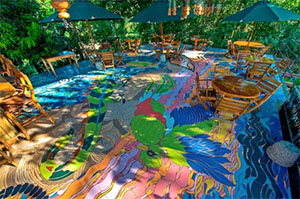 |
| Mosaic Floor at El Wagon |
This restaurant, another property of the Costa Verde complex that includes the hotel, El Avion and La Cantina, bills itself as the best pizza restaurant in Manuel Antonio and, as you'll see below, the ROMEOs could not find a reason to disagree with that claim.
The place is located on the main road to the beach and is open to the jungle on three sides. Despite having one side on the main road, traffic noise was at a minimum level probably because the dining room is situated slightly below street level. Also some of us appreciated the gentle music in the background as opposed to a loud live-music band drowning out our conversation, a happenstance occurring too frequently these days in some of the area's restaurants.
The place has one of the most beautiful mosaic tile floors around (see photo above). The dining room is more crowded now then when that photo was taken and I'm sure that's because this place has become so popular; on this day in the slow season it was virtually full. The furniture is basic, a lot of Tico wooden furniture; fits the jungle look but not good on my back (one of us, not GG, had the good sense to bring a pillow to sit on). Lighting is good, making reading of the menu easy. The composite score for ambiance came it at 3.8 sloths out of 5 max.
As mentioned, the menu is pizza driven but also offered are (Hebrew National) hot dogs and wraps stuffed with various ingredients including shrimp and fish. The menu is basically quick, simple fare for casual dining.
GG ordered a pizza (yeah, I know, not a low carb choice but I break this vow once a month for the ROMEO outings). This pizza was described as "Las Quatro Estaciones" or "Four Seasons". What came was a 12" pizza composed of one section each having toppings of artichoke, mushrooms, ham and margarita. The ingredients were fresh, tasty and the crust thin and well done. Above average for this are. Another pizza eater reported satisfaction also.
Other ROMEOs had wraps or hot dogs and reported satisfaction; more importantly they reflected in their food rating. The "postres" offering was quite limited at a piece of cheesecake or tres leches (cake soused with cream, condensed milk and evaporated milk).
The composite score for food quality for the five attending ROMEOs was 4.2/5.
|
 |
|---|---|
| $$$ | |
Value Index = 133 |
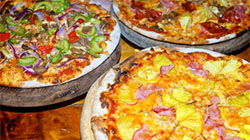 We had a primary server, a young gent who was friendly and courteous. I also noticed that the wait staff as a whole watched out for each other and kept us supplied with all the basics like water and condiments. Our composite score for service came in at 4.0, yielding an average of the same thing for ambiance, food quality and service.
We had a primary server, a young gent who was friendly and courteous. I also noticed that the wait staff as a whole watched out for each other and kept us supplied with all the basics like water and condiments. Our composite score for service came in at 4.0, yielding an average of the same thing for ambiance, food quality and service.
As usual GG's bill topped the others; for the pizza, a piece of Tres Leches and a soft drink my bill came to 11,900 colones or about $20 and change. Others reported less than 10,000 colones and, as a composite group we gave El Wagon a cost rating of 3.0 out of 5 possible. That makes the value index = 4/3 x 100 = 133 and puts El Wagon at the top level of restaurants in this area for value.
The ROMEOs can easily recommend El Wagon for a good meal at a reasonable price, particular if you're looking for casual dining.
¡Pura Vida!
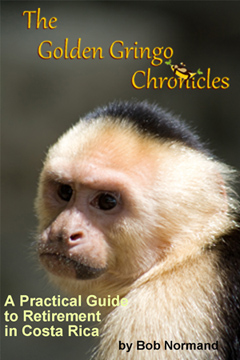 The story of the Golden Gringo Chronicles is also available as a hard copy novel of 192 pages available through Amazon and all major online retailers. ($9.95).
The story of the Golden Gringo Chronicles is also available as a hard copy novel of 192 pages available through Amazon and all major online retailers. ($9.95).
Amazon link: GGC, the Book. (Kindle Edition available)
Follow GG through the first six years of his odyssey in making the decision to retire in Costa Rica, overcoming the trials and tribulations of moving and obtaining residency there and the fun and experience of actually living in Ticoland.
Ride along with the Golden Gringo as he learns about the rich, varied culture of Costa Rica, the incredible bio diversity, the charming nature of the Costa Rican people and the ease with which a sometimes clueless ex-pat can assimilate into a small southwestern town on the Pacific coast.
Whether you are already a Costa Rican resident, someone contemplating a move here or just a traveler who enjoys different cultures, you will find the Golden Gringo Chronicles interesting, entertaining and informative about Costa Rica.
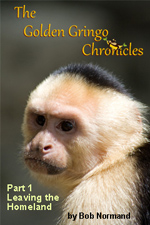 |
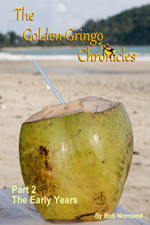 |
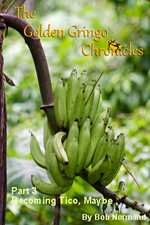 |
| Part 1 | Part 2 | Part 3 |
A narrative version of the Golden Gringo Chronicles is now also available as a trilogy of E-books in formats compatible with virtually all electronic platforms.
Part 1: (FREE!)
Leaving the Homeland
Click on Part Number above for E-book sample downloads or click the price above right for purchase. (The best price is on Part 1; it's FREE)
The Golden Gringo Chronicles is a free newsletter that is non-political, non-commercial and, hopefully, entertaining. By signing up you will receive an email each month around the first of the month giving you the links to the latest edition as well as to each individual feature and departmental section.
CLICK HERE TO SIGN-UP FOR THE
GOLDEN GRINGO CHRONICLES
or Email me at gg@goldengringo.com, and see our Website at: www.goldengringo.com

Bob Normand, Editor & The Golden Gringo
Pura Vida!
To Contact GGC World Headquarters (yuk, yuk) to make comments, suggest topics or criticize my bad jokes, just send an email to: gg@goldengringo.com.
Be pithy but kind; I'm sensitive.
Unsubscribe from Golden Gringo Chronicles